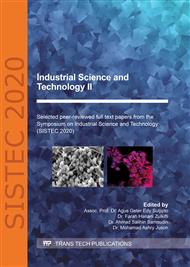[1]
S. Abrate, Modeling of impacts on composite structures,, Compos. Struct., vol. 51, no. 2, p.129–138, Feb. 2001,.
Google Scholar
[2]
L. Eckstein, L. Ickert, M. Goede, and N. Dölle, Lightweight Floor Structure with Reinforcements of CFRP and GFRP,, ATZautotechnology, vol. 11, no. 2, p.48–53, Apr. 2011,.
DOI: 10.1365/s35595-011-0025-4
Google Scholar
[3]
C. Kassapoglou, Design and Analysis of Composite Structures. Oxford, UK: John Wiley & Sons Ltd, (2013).
Google Scholar
[4]
A. Hiken, The Evolution of the Composite Fuselage - A Manufacturing Perspective,, SAE Int. J. Aerosp., vol. 10, no. 2, pp.2017-01–2154, Sep. 2017,.
DOI: 10.4271/2017-01-2154
Google Scholar
[5]
N. Zimmermann and P. H. Wang, A review of failure modes and fracture analysis of aircraft composite materials,, Eng. Fail. Anal., vol. 115, no. June, p.104692, 2020,.
DOI: 10.1016/j.engfailanal.2020.104692
Google Scholar
[6]
K. V. N. Gopal, Product design for advanced composite materials in aerospace engineering,, in Advanced Composite Materials for Aerospace Engineering, Elsevier, 2016, p.413–428.
DOI: 10.1016/b978-0-08-100037-3.00014-6
Google Scholar
[7]
Z. Denchev and N. Dencheva, Manufacturing and Properties of Aramid Reinforced Composites,, in Synthetic Polymer-Polymer Composites Manufacturing and Properties, S. BHATTACHARYYA, DEBES; FAKIROV, Ed. Munich: Hanser Publishers, 2012, p.251–280.
DOI: 10.3139/9781569905258.008
Google Scholar
[8]
M. R. Piggott, A theoretical framework for the compressive properties of aligned fibre composites,, J. Mater. Sci., vol. 16, p.2837–2845, 1981, doi: https://doi.org/10.1007/BF02402848.
DOI: 10.1007/bf02402848
Google Scholar
[9]
A. R. Othman and M. H. Hassan, Effect of different construction designs of aramid fabric on the ballistic performances,, vol. 44, p.407–413, 2013,.
DOI: 10.1016/j.matdes.2012.07.061
Google Scholar
[10]
C. Yang, T. Ngo, and P. Tran, Influences of weaving architectures on the impact resistance of multi-layer fabrics,, vol. 85, p.282–295, 2015,.
DOI: 10.1016/j.matdes.2015.07.014
Google Scholar
[11]
A. Kumar, V. V Chavan, S. Ahmad, and R. Alagirusamy, International Journal of Impact Engineering Ballistic impact response of Kevlar ® reinforced thermoplastic composite armors,, Int. J. Impact Eng., vol. 89, p.1–13, 2016,.
DOI: 10.1016/j.ijimpeng.2015.10.014
Google Scholar
[12]
P. L. Stumpff, Fractography,, Composites, vol. 21. ASM International, p.0, Jan. 01, 2001,.
Google Scholar
[13]
ASTM International, ASTM D3039 / D3039M-17, Standard Test Method for Tensile Properties of Polymer Matrix Composite Materials,, West Conshohocken; PA, 2017.
Google Scholar
[14]
ASTM International, ASTM D 3410, Standard Test Method for Compressive Properties of Polymer Matrix Composite Materials with Unsupported Gage Section by Shear,, vol. 08, p.1–16, 2016,.
DOI: 10.1520/d3410_d3410m-16
Google Scholar
[15]
L. Shikhmanter, I. Eldror, and B. Cina, Fractography of unidirectional CFRP composites,, J. Mater. Sci., vol. 24, no. 1, p.167–172, 1989,.
DOI: 10.1007/bf00660949
Google Scholar
[16]
M. S. Vinod, B. J. Sunil, V. Nayaka, R. Shenoy, M. S. Murali, and A. Nafidi, Fractography of compression failed carbon fiber reinforced plastic composite laminates,, vol. 2, no. February, p.1–9, (2010).
Google Scholar
[17]
ASTM International, Designation: D790 – 02 'Standard test methods for flexural properties of unreinforced and reinforced electrical insulating materials,', Annu. B. ASTM Stand., vol. 14, p.146–154, 2003, [Online]. Available: www.astm.org.
Google Scholar
[18]
ASTM International, ASTM D 2344, Standard Test Method for Apparent Interlaminar Shear Strength of Parallel Fiber,, vol. 84, p.6–8, (1995).
Google Scholar
[19]
CASA Engineering and System Direction, Data Sheet 120 degree Celcius Cure Epoxy Resin Preimpregnated Aramid Fiber Fabric,, (2001).
Google Scholar
[20]
A. Merati, Materials replacement for aging aircraft,, Corros. Fatigue Environ. Assist. Crack. Aging Mil. Veh., p.21–24, (2011).
Google Scholar
[21]
T. Dursun and C. Soutis, Recent developments in advanced aircraft aluminium alloys,, Mater. Des., vol. 56, p.862–871, 2014,.
DOI: 10.1016/j.matdes.2013.12.002
Google Scholar


